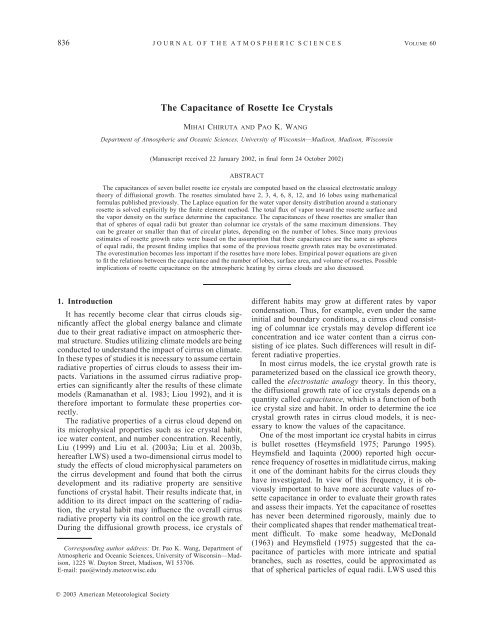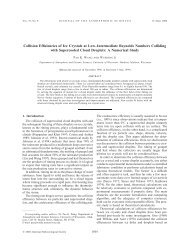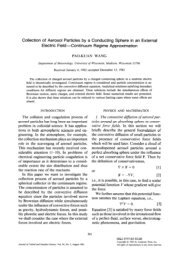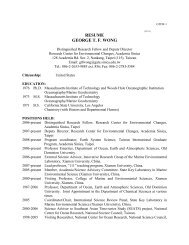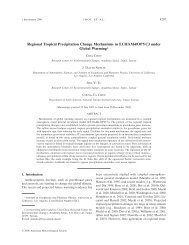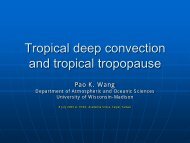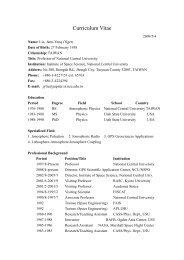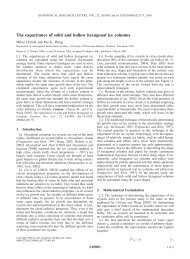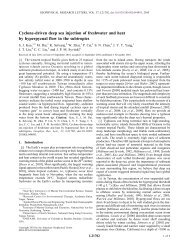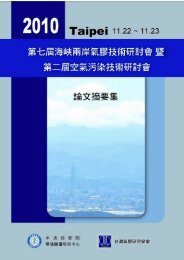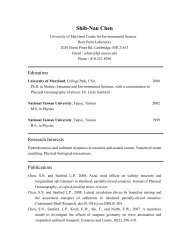The Capacitance of Rosette Ice Crystals - University of Wisconsin ...
The Capacitance of Rosette Ice Crystals - University of Wisconsin ...
The Capacitance of Rosette Ice Crystals - University of Wisconsin ...
Create successful ePaper yourself
Turn your PDF publications into a flip-book with our unique Google optimized e-Paper software.
836 JOURNAL OF THE ATMOSPHERIC SCIENCES<br />
VOLUME 60<br />
<strong>The</strong> <strong>Capacitance</strong> <strong>of</strong> <strong>Rosette</strong> <strong>Ice</strong> <strong>Crystals</strong><br />
MIHAI CHIRUTA AND PAO K. WANG<br />
Department <strong>of</strong> Atmospheric and Oceanic Sciences, <strong>University</strong> <strong>of</strong> <strong>Wisconsin</strong>—Madison, Madison, <strong>Wisconsin</strong><br />
(Manuscript received 22 January 2002, in final form 24 October 2002)<br />
ABSTRACT<br />
<strong>The</strong> capacitances <strong>of</strong> seven bullet rosette ice crystals are computed based on the classical electrostatic analogy<br />
theory <strong>of</strong> diffusional growth. <strong>The</strong> rosettes simulated have 2, 3, 4, 6, 8, 12, and 16 lobes using mathematical<br />
formulas published previously. <strong>The</strong> Laplace equation for the water vapor density distribution around a stationary<br />
rosette is solved explicitly by the finite element method. <strong>The</strong> total flux <strong>of</strong> vapor toward the rosette surface and<br />
the vapor density on the surface determine the capacitance. <strong>The</strong> capacitances <strong>of</strong> these rosettes are smaller than<br />
that <strong>of</strong> spheres <strong>of</strong> equal radii but greater than columnar ice crystals <strong>of</strong> the same maximum dimensions. <strong>The</strong>y<br />
can be greater or smaller than that <strong>of</strong> circular plates, depending on the number <strong>of</strong> lobes. Since many previous<br />
estimates <strong>of</strong> rosette growth rates were based on the assumption that their capacitances are the same as spheres<br />
<strong>of</strong> equal radii, the present finding implies that some <strong>of</strong> the previous rosette growth rates may be overestimated.<br />
<strong>The</strong> overestimation becomes less important if the rosettes have more lobes. Empirical power equations are given<br />
to fit the relations between the capacitance and the number <strong>of</strong> lobes, surface area, and volume <strong>of</strong> rosettes. Possible<br />
implications <strong>of</strong> rosette capacitance on the atmospheric heating by cirrus clouds are also discussed.<br />
1. Introduction<br />
It has recently become clear that cirrus clouds significantly<br />
affect the global energy balance and climate<br />
due to their great radiative impact on atmospheric thermal<br />
structure. Studies utilizing climate models are being<br />
conducted to understand the impact <strong>of</strong> cirrus on climate.<br />
In these types <strong>of</strong> studies it is necessary to assume certain<br />
radiative properties <strong>of</strong> cirrus clouds to assess their impacts.<br />
Variations in the assumed cirrus radiative properties<br />
can significantly alter the results <strong>of</strong> these climate<br />
models (Ramanathan et al. 1983; Liou 1992), and it is<br />
therefore important to formulate these properties correctly.<br />
<strong>The</strong> radiative properties <strong>of</strong> a cirrus cloud depend on<br />
its microphysical properties such as ice crystal habit,<br />
ice water content, and number concentration. Recently,<br />
Liu (1999) and Liu et al. (2003a; Liu et al. 2003b,<br />
hereafter LWS) used a two-dimensional cirrus model to<br />
study the effects <strong>of</strong> cloud microphysical parameters on<br />
the cirrus development and found that both the cirrus<br />
development and its radiative property are sensitive<br />
functions <strong>of</strong> crystal habit. <strong>The</strong>ir results indicate that, in<br />
addition to its direct impact on the scattering <strong>of</strong> radiation,<br />
the crystal habit may influence the overall cirrus<br />
radiative property via its control on the ice growth rate.<br />
During the diffusional growth process, ice crystals <strong>of</strong><br />
Corresponding author address: Dr. Pao K. Wang, Department <strong>of</strong><br />
Atmospheric and Oceanic Sciences, <strong>University</strong> <strong>of</strong> <strong>Wisconsin</strong>—Madison,<br />
1225 W. Dayton Street, Madison, WI 53706.<br />
E-mail: pao@windy.meteor.wisc.edu<br />
different habits may grow at different rates by vapor<br />
condensation. Thus, for example, even under the same<br />
initial and boundary conditions, a cirrus cloud consisting<br />
<strong>of</strong> columnar ice crystals may develop different ice<br />
concentration and ice water content than a cirrus consisting<br />
<strong>of</strong> ice plates. Such differences will result in different<br />
radiative properties.<br />
In most cirrus models, the ice crystal growth rate is<br />
parameterized based on the classical ice growth theory,<br />
called the electrostatic analogy theory. In this theory,<br />
the diffusional growth rate <strong>of</strong> ice crystals depends on a<br />
quantity called capacitance, which is a function <strong>of</strong> both<br />
ice crystal size and habit. In order to determine the ice<br />
crystal growth rates in cirrus cloud models, it is necessary<br />
to know the values <strong>of</strong> the capacitance.<br />
One <strong>of</strong> the most important ice crystal habits in cirrus<br />
is bullet rosettes (Heymsfield 1975; Parungo 1995).<br />
Heymsfield and Iaquinta (2000) reported high occurrence<br />
frequency <strong>of</strong> rosettes in midlatitude cirrus, making<br />
it one <strong>of</strong> the dominant habits for the cirrus clouds they<br />
have investigated. In view <strong>of</strong> this frequency, it is obviously<br />
important to have more accurate values <strong>of</strong> rosette<br />
capacitance in order to evaluate their growth rates<br />
and assess their impacts. Yet the capacitance <strong>of</strong> rosettes<br />
has never been determined rigorously, mainly due to<br />
their complicated shapes that render mathematical treatment<br />
difficult. To make some headway, McDonald<br />
(1963) and Heymsfield (1975) suggested that the capacitance<br />
<strong>of</strong> particles with more intricate and spatial<br />
branches, such as rosettes, could be approximated as<br />
that <strong>of</strong> spherical particles <strong>of</strong> equal radii. LWS used this<br />
2003 American Meteorological Society
15 MARCH 2003 CHIRUTA AND WANG<br />
837<br />
approximation to determine the growth rate <strong>of</strong> rosettes<br />
and showed that a cirrus cloud consisting <strong>of</strong> bullet rosettes<br />
would have much larger radiative effect than cirrus<br />
clouds <strong>of</strong> other ice crystal habits. Given the same<br />
initial environmental conditions, a peak heating rate due<br />
to infrared radiation for rosette cirrus, for cirrus ice<br />
columns and ice plates, and for spheres would be 2.5,<br />
2, and 6 times greater, respectively. Its heating rate due<br />
to shortwave solar radiation is also substantially greater<br />
than other habits. Such a high potential impact on the<br />
atmospheric heating rates makes the determination <strong>of</strong><br />
the bullet rosette capacitance even more urgent.<br />
This paper is devoted to the task <strong>of</strong> calculating the<br />
capacitance <strong>of</strong> bullet rosette ice crystals. In the following<br />
sections, we will first review briefly the electrostatic<br />
analogy theory <strong>of</strong> ice crystal diffusional growth to clarify<br />
the role <strong>of</strong> the capacitance. <strong>The</strong>n we will describe<br />
the techniques <strong>of</strong> simulating the shapes <strong>of</strong> these rosettes<br />
and the methods <strong>of</strong> determining their capacitance. This<br />
will be followed by the discussion <strong>of</strong> the results and<br />
conclusions.<br />
2. A brief review <strong>of</strong> the electrostatic analogy<br />
theory <strong>of</strong> ice crystal growth<br />
<strong>The</strong> classical theory <strong>of</strong> ice crystal growth is called<br />
electrostatic analogy because it dwells on the similarity<br />
between the equations governing the water vapor distribution<br />
around an ice crystal and the electrostatic potential<br />
distribution around an electric conductor <strong>of</strong> the<br />
same shape as the ice crystal. A detailed discussion can<br />
be found in standard textbooks <strong>of</strong> cloud physics (e.g.,<br />
Pruppacher and Klett 1997; Hobbs 1976; Young 1993).<br />
<strong>The</strong> following is a brief outline.<br />
Note that the electrostatic analogy is only relevant to<br />
the growth <strong>of</strong> stationary ice crystals. Another important<br />
effect on the crystal growth, the ventilation effect that<br />
results from the motion <strong>of</strong> the crystal, requires the solutions<br />
<strong>of</strong> the Navier–Stokes equations for flow past<br />
rosette crystals, but unfortunately the solutions are not<br />
available at present.<br />
<strong>The</strong> distribution <strong>of</strong> water vapor density around a<br />
stationary ice crystal <strong>of</strong> arbitrary shape satisfies the Laplace<br />
equation<br />
2<br />
0,<br />
(1)<br />
with the following boundary conditions:<br />
s<br />
at the crystal’s surface,<br />
<br />
<br />
(2)<br />
far away from the crystal,<br />
<br />
where both s and are constant. In electrostatics, the<br />
electric potential around a conductor <strong>of</strong> the same (arbitrary)<br />
shape as the ice crystal would also satisfies the<br />
Laplace equation<br />
2<br />
0, (3)<br />
with the boundary conditions<br />
U on the crystal’s surface,<br />
<br />
<br />
(4)<br />
0 at the outer boundary <strong>of</strong> the domain.<br />
Obviously, equation set (1) and (2) are completely<br />
equivalent to equation set (3) and (4), the only difference<br />
being the symbols. Thus, if the set (3) and (4) can be<br />
solved, the same solution would also satisfy the set (1)<br />
and (2). However, due to the complicated shapes <strong>of</strong> most<br />
ice crystals, we rarely solve these equations directly to<br />
determine the distributions <strong>of</strong> and (although this<br />
was done in Ji and Wang 1999). Instead, since the main<br />
purpose <strong>of</strong> such calculations is to determine the ice crystal<br />
diffusional growth rate given by the integral<br />
dm D · ds, (5)<br />
dt<br />
s<br />
where m is the mass <strong>of</strong> the ice crystal, D the diffusivity<br />
<strong>of</strong> water vapor in air, and ds the infinitesimal increment<br />
<strong>of</strong> an arbitrary surface enclosing the ice crystal, it turns<br />
out that we can bypass the determination the explicit <br />
distribution. This understanding stems from the wellknown<br />
Gauss law in the classical electrostatics, which<br />
states that the enclosing surface integral <strong>of</strong> the electric<br />
flux density equals the total charge Q on the conductor.<br />
On the other hand, the total charge Q is related to<br />
the electric potential by the following expression:<br />
Q C(U 0) CU, (6)<br />
where C is the capacitance <strong>of</strong> the conductor. Equation<br />
(6) is independent <strong>of</strong> the shape <strong>of</strong> the conductor. According<br />
to this analogy (see Pruppacher and Klett 1997<br />
for details), the term dm/dt in (5) is analogous to Q and<br />
thus can be calculated by<br />
dm 4D C( s ). (7)<br />
dt<br />
Equation (7) indicates that the growth rate <strong>of</strong> the ice<br />
crystal can be determined if its capacitance C is known.<br />
All other quantities on the right-hand side <strong>of</strong> (7) are<br />
independent <strong>of</strong> the shape.<br />
<strong>The</strong> capacitance C in (7) can be either calculated or<br />
measured experimentally. While the capacitances <strong>of</strong> some<br />
simpler ice crystal shapes such as columns and plates<br />
have been theoretically calculated approximately or measured<br />
directly by using metal models <strong>of</strong> the crystals<br />
(McDonald 1963; Podzimek 1966; also see Pruppacher<br />
and Klett 1997, chapter 13), neither has ever been attempted<br />
for the important case <strong>of</strong> bullet rosettes. To our<br />
knowledge, the present study is the first to do so.<br />
3. Mathematical determination <strong>of</strong> capacitance<br />
a. Nondimensionalization <strong>of</strong> the governing equations<br />
<strong>The</strong> main idea <strong>of</strong> determining the capacitance <strong>of</strong> a<br />
rosette is to utilize Eq. (7), namely, we shall determine<br />
dm/dt explicitly and then use (7) to obtain the capacitance<br />
C. This is analogous to determining the electric
838 JOURNAL OF THE ATMOSPHERIC SCIENCES<br />
VOLUME 60<br />
capacitance <strong>of</strong> a conductor with known potentials on<br />
the surface and at infinity. To determine dm/dt, we need<br />
to explicitly solve the water vapor density distribution<br />
first. <strong>The</strong> governing equations for our problem are therefore<br />
Eq. (1), subject to appropriate boundary conditions.<br />
<strong>The</strong> Laplace equation will be made dimensionless first<br />
for the convenience <strong>of</strong> analysis:<br />
2<br />
0,<br />
(8)<br />
where the primed quantity in the integrand are nondimensionalized<br />
according to the following relations:<br />
<br />
<br />
r<br />
<br />
, r , (9)<br />
<br />
a<br />
s<br />
<br />
where a is the radius <strong>of</strong> the ice crystal and r the radial<br />
distance from the origin, which is defined at the center<br />
<strong>of</strong> the ice crystal in the present study. <strong>The</strong> radius <strong>of</strong> the<br />
rosette considered here is defined as the distance from<br />
the center <strong>of</strong> the rosette to the tip <strong>of</strong> one <strong>of</strong> the lobes.<br />
We assume that all lobes have the same length in this<br />
study.<br />
Once the vapor density distribution is determined,<br />
the capacitance is obtained by<br />
<br />
a<br />
C · ds. (10)<br />
4<br />
s<br />
Smythe (1956, 1962) and Wang et al. (1985) performed<br />
similar calculations to determine the capacitance <strong>of</strong> right<br />
circular cylinders <strong>of</strong> finite lengths by solving the Laplace<br />
equation analytically. In view <strong>of</strong> the more complicated<br />
rosette shape in the present study, we will use<br />
numerical techniques instead.<br />
We need to carefully define appropriate boundary<br />
conditions for our numerical problem. Since the capacitance<br />
is a function <strong>of</strong> the position <strong>of</strong> these boundaries,<br />
the capacitance <strong>of</strong> an isolated conductor will be different<br />
from the same conductor when it is placed near another<br />
charged body with a certain potential. This means that<br />
the distance <strong>of</strong> the outer boundary may have an effect<br />
on the precise value <strong>of</strong> the capacitance. In atmospheric<br />
clouds, the mean distance between individual cloud particles<br />
is rather large relative to the particle size, typically<br />
on the order <strong>of</strong> many tens to hundreds <strong>of</strong> particle radii<br />
(Prupppacher and Klett 1997). Thus the ice particles can<br />
<strong>of</strong>ten be considered as isolated individual particles, and<br />
hence the most relevant capacitance for our purpose here<br />
will be that <strong>of</strong> an isolated ice crystal; that is, the outer<br />
boundary should be placed at infinity. Thus boundary<br />
condition (2) is appropriate. In numerical calculations,<br />
the term ‘‘infinity’’ is replaced by ‘‘sufficiently far<br />
away.’’ In nondimensional form, the appropriate boundary<br />
conditions for the present situation are<br />
<br />
<br />
1 on the surface <strong>of</strong> the rosette,<br />
0 at a distance far away from the rosette.<br />
(11)<br />
b. Treatment <strong>of</strong> the boundary conditions<br />
1) THE INNER BOUNDARY<br />
We will use the finite element techniques to solve the<br />
Laplace equation (8) subject to the boundary conditions<br />
(11). This requires setting up a grid system for the computational<br />
domain between the inner and outer boundaries.<br />
<strong>The</strong> first step for this analysis is to prescribe the<br />
boundary points.<br />
<strong>The</strong> inner boundary is the surface <strong>of</strong> the bullet rosette.<br />
<strong>The</strong> shape <strong>of</strong> a bullet rosette is highly complicated, and<br />
it is not easy to determine the coordinates <strong>of</strong> the boundary<br />
surface. To simplify this problem, we use the successive<br />
modification <strong>of</strong> simple shapes (SMOSS) technique<br />
developed by Wang (1997, 1999, 2002) to simulate<br />
the shape <strong>of</strong> ice crystals. <strong>The</strong> mathematical expression<br />
specific for this case is given in Wang (1999):<br />
2 2 <br />
r {[cos (m)] } {[sin (n)] } .<br />
(12)<br />
This equation is expressed in spherical coordinates so<br />
that r is the radial, the zenithal, and the azimuthal<br />
coordinates. <strong>The</strong> parameters , , , , , , , and<br />
are freely adjustable in order to fit the shape <strong>of</strong> a<br />
particular rosette. <strong>The</strong> shape generated by this expression<br />
will have 2mn lobes or branches. For example, a<br />
four-branch combination <strong>of</strong> bullets can be generated by<br />
the following expression:<br />
4 20 4 20<br />
r [1 cos(2) ] [1 sin() ] , (13)<br />
where m 2 and n 1 here. <strong>The</strong> width <strong>of</strong> the branch<br />
is controlled by and in (12). Obviously, it is impossible<br />
that such a simple expression will reproduce<br />
all the intricate structures, but at least it captures the<br />
essential multilobe feature that is characteristic <strong>of</strong> bullet<br />
rosette crystals.<br />
2) THE OUTER BOUNDARY<br />
Although the inner boundary <strong>of</strong> the problem is not<br />
spherically symmetric, the outer boundary <strong>of</strong> the present<br />
problem, if set at infinity, will be a sphere, as the distribution<br />
<strong>of</strong> any field whose source is finite (such as the<br />
rosette considered here) will become spherically symmetric<br />
when the distance approaches infinity. However,<br />
in numerical calculations, the distance <strong>of</strong> the outer<br />
boundary from the origin has to remain finite and hence<br />
the field distribution here may deviate from being truly<br />
spherically symmetric. In the present study, we assume<br />
that this finite outer boundary surface is also spherical.<br />
In order to assess the impact <strong>of</strong> this assumption on the<br />
accuracy <strong>of</strong> the results, we performed tests to determine<br />
how sensitive the results are to the outer boundary distance.<br />
It turns out that the results are not very sensitive<br />
to the outer boundary distance as long as it is at least<br />
seven radii away from the center <strong>of</strong> the crystal. Further
15 MARCH 2003 CHIRUTA AND WANG<br />
839<br />
FIG. 1. <strong>The</strong> seven simulated bullet rosette ice crystals and their generating equations, surface area (S), volume (V), and the projected<br />
areas in x, y, and z direction. <strong>The</strong> areas are in units <strong>of</strong> a 2 , and the volume in a 3 .<br />
discussion on the sensitivity tests will be included in<br />
the next section.<br />
A brief description <strong>of</strong> the discretization techniques<br />
used for the present study and an example <strong>of</strong> the grid<br />
structure are given in the appendix.<br />
4. Results and discussion<br />
<strong>The</strong> capacitances <strong>of</strong> seven bullets rosette crystals are<br />
calculated using the techniques outlined in the previous<br />
section. <strong>The</strong>se rosettes have 2, 3, 4, 6, 8, 12, and 16<br />
lobes. <strong>The</strong>se rosette cases are chosen because their geometrical<br />
symmetries render them easier for mathematical<br />
treatment. <strong>The</strong> mathematical expressions for the<br />
rosettes and plots <strong>of</strong> their shapes are shown in Fig. 1.<br />
<strong>The</strong> rosettes look visually reasonable when compared<br />
with photographs <strong>of</strong> actual samples. More quantitative<br />
discussions <strong>of</strong> their geometrical properties are given in<br />
the next section. Due to the limitation <strong>of</strong> the formulas,<br />
it is sometimes difficult to obtain a completely symmetric<br />
shape for individual lobes. Thus sometimes the<br />
dimension <strong>of</strong> a lobe in direction is substantially different<br />
than that in direction. But the multilobe characteristic<br />
<strong>of</strong> the rosettes is well reproduced. <strong>The</strong> crystals<br />
generated in this way have the lobes <strong>of</strong> equal length a.<br />
Also included in Fig. 1 are values <strong>of</strong> the rosettes’ total<br />
surface areas, volumes, and the cross-sectional areas S x ,<br />
S y , and S z projected in the x, y, and z axis, respectively.<br />
As an example, Fig. 2 shows plots <strong>of</strong> the projected crosssectional<br />
areas <strong>of</strong> an eight-lobed rosette.<br />
a. Geometrical properties <strong>of</strong> the modeled rosettes<br />
It is useful to briefly mention some geometrical properties<br />
<strong>of</strong> the modeled rosettes. Figure 3 shows the variation<br />
<strong>of</strong> the rosettes’ surface areas and volumes with
840 JOURNAL OF THE ATMOSPHERIC SCIENCES<br />
VOLUME 60<br />
FIG. 2. <strong>The</strong> projected areas S x , S y , and S z <strong>of</strong> an eight-lobed bullet<br />
rosette simulated in the study.<br />
the number <strong>of</strong> lobes. It appears that while both the surface<br />
area and volume increase with the number <strong>of</strong> lobes,<br />
the increasing rates are not uniform that may be due to<br />
the specific set <strong>of</strong> parameter values used. <strong>The</strong> solid<br />
curves represent power fit by the following formulas:<br />
0.7727 2<br />
A 1.5528N a (surface area) and<br />
FIG. 4. Variation <strong>of</strong> surface area vs radius <strong>of</strong> rosettes. Here N<br />
represents the number <strong>of</strong> lobes <strong>of</strong> the rosette. <strong>The</strong> thick curve is for<br />
spheres.<br />
0.5206 3<br />
V 0.3257N a (volume). (14)<br />
Higher-order polynomials can fit even closer, but we<br />
feel it is unnecessary.<br />
Figures 4 and 5 show the plots <strong>of</strong> the surface area<br />
and volume versus the radius as computed from (14)<br />
for all seven-rosette cases. It is seen that the surface<br />
areas <strong>of</strong> all rosettes, except the 16-lobed ones, are smaller<br />
than that <strong>of</strong> a sphere <strong>of</strong> equal radius. On the other<br />
hand, the sphere volume is always greater than the volume<br />
<strong>of</strong> a rosette regardless <strong>of</strong> the number <strong>of</strong> lobes.<br />
Naturally, as the number <strong>of</strong> rosette lobes increases, the<br />
volume increases also.<br />
Heymsfield and Iaquinta (2000) presented some observational<br />
results <strong>of</strong> bullet rosettes in cirrus clouds, and<br />
it is useful to compare their geometrical properties with<br />
the simulated models in this study. Since the models<br />
used in this study are dimensionless, the most convenient<br />
parameter for comparing the geometrical properties<br />
is the aspect ratio, defined as the width w divided<br />
by the length L <strong>of</strong> a bullet.<br />
To determine the aspect ratio <strong>of</strong> the seven rosettes we<br />
used the maximum width <strong>of</strong> the lobe as the width <strong>of</strong><br />
the bullet. <strong>The</strong> length L is <strong>of</strong> course equal to a <strong>of</strong> the<br />
lobe. <strong>The</strong> aspect ratios <strong>of</strong> the modeled rosettes, so determined,<br />
vary between 0.35 0.6. Those with fewer<br />
lobes are usually associated with larger aspect ratios and<br />
those with more lobes are associated with smaller aspect<br />
ratios, but the relation is not monotonic. This range <strong>of</strong><br />
aspect ratios appears to be consistent with the majority<br />
<strong>of</strong> the bullet rosettes observed by Heymsfield and Iaquinta<br />
(2000).<br />
FIG. 3. Variation <strong>of</strong> the surface area and volume <strong>of</strong> the simulated<br />
rosettes as a function <strong>of</strong> number <strong>of</strong> lobes.<br />
FIG. 5. Variation <strong>of</strong> volume vs radius <strong>of</strong> rosettes. Here N represents<br />
the number <strong>of</strong> lobes <strong>of</strong> the rosette. <strong>The</strong> thick curve is for spheres.
15 MARCH 2003 CHIRUTA AND WANG<br />
841<br />
<strong>The</strong> volume <strong>of</strong> a bullet rosette calculated using (14)<br />
is also generally consistent with that calculated using<br />
the empirical formula given by Heymsfield and Iaquinta.<br />
For example, the volume <strong>of</strong> a five-lobed rosette calculated<br />
from (14) will be the same (0.75 a 3 ) as that<br />
calculated using their Eq. (A10) if the aspect ratio is<br />
taken to be 0.45. It is noted that (14) does not include<br />
the aspect ratio effect, hence the volume calculated by<br />
it will be different from Heymsfield and Iaquinta’s formula<br />
if the aspect ratio changes.<br />
Yang et al. (2000) also suggested a few empirical<br />
parameters to characterize the geometrical properties <strong>of</strong><br />
nonspherical ice particles including rosettes. <strong>The</strong>ir main<br />
purpose was for the parameterization <strong>of</strong> scattering and<br />
absorption properties <strong>of</strong> these particles. One <strong>of</strong> the parameters<br />
they suggested is the equivalent radius d e defined<br />
as 1.5 (V/A), where V is the volume and A the<br />
projected area. <strong>The</strong> four-and six-lobed rosettes modeled<br />
in the present study resemble that described in Yang et<br />
al. (2000) and have d e varying with a in a similar manner,<br />
but the values are larger for the same maximum<br />
dimension. <strong>The</strong> differences are smaller when rosettes<br />
are small but become much larger when rosettes reach<br />
millimeter size. More research is needed to understand<br />
the significance <strong>of</strong> such differences.<br />
FIG. 6. <strong>The</strong> computed capacitance <strong>of</strong> an eight-lobed rosette as a<br />
function <strong>of</strong> the outer boundary distance.<br />
b. <strong>Capacitance</strong>s <strong>of</strong> rosettes<br />
Since both the grid resolution and the distance <strong>of</strong><br />
outer boundary may influence the precision <strong>of</strong> the results,<br />
we performed several sensitivity tests in order to<br />
ensure the accuracy <strong>of</strong> the computed capacitances. <strong>The</strong><br />
first test is on the sensitivity <strong>of</strong> grid resolution. Several<br />
grids were set up for the solutions <strong>of</strong> in (8) and the<br />
results compared. If the results are similar (less than<br />
about 5% difference), the one with the least resolution<br />
is adopted as the grid for the calculations to achieve<br />
computational efficiency.<br />
<strong>The</strong> second test is on the sensitivity <strong>of</strong> the distance<br />
<strong>of</strong> the outer boundary. This distance was set at different<br />
values from 2.5 to 15 and the respective capacitance<br />
was computed accordingly. As an example, the computed<br />
capacitances <strong>of</strong> an eight-lobed rosette with different<br />
outer boundary distances are shown in Fig. 6. We<br />
see in Fig. 6 that as the distance <strong>of</strong> the outer boundary<br />
b increases, the capacitance <strong>of</strong> the rosette decreases and<br />
approaches an asymptotic value. This asymptotic value<br />
should represent the capacitance <strong>of</strong> an isolated rosette<br />
(i.e., when the outer boundary is set at infinity) and is<br />
the value reported here. As mentioned before, the capacitance<br />
becomes more or less constant for outer<br />
boundary distance greater than 6 radii.<br />
To determine the capacitance, the numerical solutions<br />
<strong>of</strong> are fed into Eq. (10) and the integral is computed<br />
numerically. In an exact analytical theory, the results <strong>of</strong><br />
integration is independent <strong>of</strong> the surface chosen because<br />
<strong>of</strong> the steady-state condition implied in the formulation,<br />
but in numerical calculations these results may be somewhat<br />
different due to numerical errors in the solutions<br />
<strong>of</strong> . In order to ensure accuracy, we performed the<br />
integration in (10) over 10 different surfaces to make<br />
sure that errors are insignificant. It turned out that the<br />
differences are typically less than 5%, thus an averaged<br />
value <strong>of</strong> all <strong>of</strong> these results should be representative <strong>of</strong><br />
the true value <strong>of</strong> the capacitance.<br />
<strong>The</strong> computed capacitances <strong>of</strong> the rosettes as a function<br />
<strong>of</strong> the number <strong>of</strong> lobes are shown in Fig. 7. <strong>The</strong><br />
slight scatter in the results is largely due to the shape<br />
parameters chosen in Eq. (12). However, the general<br />
trend <strong>of</strong> the curve is fairly clear and the scatter should<br />
not influence the conclusions to any significant extent.<br />
It is seen in Fig. 7 that the rosette capacitance increases<br />
from about 0.5 to near 0.9 (in unit <strong>of</strong> a) as the number<br />
<strong>of</strong> lobes increases from 2 to 16. <strong>The</strong> capacitance <strong>of</strong> a<br />
conducting sphere is its radius a. Thus it appears that the<br />
capacitance <strong>of</strong> a rosette will approach that <strong>of</strong> a sphere if<br />
the number <strong>of</strong> lobes approaches infinity, that is, as its<br />
shape approaches a sphere. <strong>The</strong> following power relation<br />
can fit the rosette capacitance curve in Fig. 7:<br />
0.257<br />
C 0.434N , (15)<br />
where C is the capacitance in unit <strong>of</strong> a and N is the<br />
number <strong>of</strong> lobes.<br />
Figure 7 thus shows that the capacitance <strong>of</strong> a rosette<br />
is smaller than that <strong>of</strong> a sphere <strong>of</strong> equal radius. This<br />
implies that calculations <strong>of</strong> the rosette growth rate based<br />
on the spherical capacitance assumption overestimate.<br />
<strong>The</strong> overestimation is the most serious for rosettes with<br />
fewer lobes but becomes less if the number <strong>of</strong> lobes is<br />
large.<br />
<strong>The</strong> capacitances <strong>of</strong> a thin circular plate and two cases<br />
<strong>of</strong> prolate spheroids are also shown in Fig. 7 for comparison.<br />
<strong>The</strong>se shapes have been used previously as ap-
842 JOURNAL OF THE ATMOSPHERIC SCIENCES<br />
VOLUME 60<br />
FIG. 7. Computed capacitance (diamonds) <strong>of</strong> rosettes as a function<br />
<strong>of</strong> number <strong>of</strong> lobes. Thick solid curve represent power fit by Eq.<br />
(15). Also shown are the capacitances <strong>of</strong> a sphere (thin solid line),<br />
a circular plate (dashed), and two prolate spheroids with semiaxis<br />
ratio a/b 2 and 5, respectively. <strong>The</strong> rosettes, the sphere, and circular<br />
plate all have a radius a.<br />
proximations for ice plates and ice columns and their<br />
capacitance formulas are given as<br />
2a<br />
C (circular plate) and<br />
<br />
2 2<br />
a c<br />
C (prolate spheroid), (16)<br />
ln(2a/c)<br />
where a and c in the second equation represent the semimajor<br />
and semiminor axes <strong>of</strong> the prolate spheroid, respectively<br />
(see Pruppacher and Klett 1997, chapter 13,<br />
p. 548). Note that the semilength (the longer dimension)<br />
instead <strong>of</strong> the radius <strong>of</strong> the prolate spheroid is denoted<br />
as a. McDonald (1963) and Podzimek (1966) performed<br />
laboratory measurements <strong>of</strong> the capacitances <strong>of</strong> metal<br />
models <strong>of</strong> ice columns, plates, and dendrites, and their<br />
results are close to that given by Eq. (16), usually to<br />
about 10% or less. Only the highly skeleton stellar crystal<br />
[P1d in Magono–Lee classification, see Magono and<br />
Lee (1966)] has a capacitance about 23% less than that<br />
given by the plate in (16). Hence the capacitances given<br />
by (16) are fairly representative <strong>of</strong> the atmospheric ice<br />
crystals.<br />
We will use the capacitance <strong>of</strong> a prolate spheroid to<br />
approximate that <strong>of</strong> a hexagonal column in the following<br />
discussion. We see that the capacitance <strong>of</strong> a two-lobed<br />
rosette crystal is smaller than that <strong>of</strong> a short column (a<br />
2c) (C 0.65) but is greater than that <strong>of</strong> a long thin<br />
column (a 5c). A five-lobed rosette has a capacitance<br />
close to that <strong>of</strong> a short column. This implies that the<br />
growth rate <strong>of</strong> a rosette ice crystal is usually greater<br />
FIG. 8. Variation <strong>of</strong> capacitance with radius <strong>of</strong> rosettes calculated<br />
using (15). Here N represents the number <strong>of</strong> lobes <strong>of</strong> the rosette. <strong>The</strong><br />
thick curve is for spheres.<br />
than that <strong>of</strong> a long thin column and may even be greater<br />
than a short column if it has more than five lobes.<br />
<strong>The</strong> capacitance <strong>of</strong> a circular plate is greater than that<br />
<strong>of</strong> rosettes <strong>of</strong> the same radii up to five lobes, but becomes<br />
smaller than rosette capacitance as the number<br />
<strong>of</strong> rosette lobes increases. If the rosette has more than<br />
five lobes, its growth rate will be faster than an ice plate<br />
<strong>of</strong> the same dimension.<br />
Figure 8 shows the plot <strong>of</strong> capacitance versus radius<br />
for rosettes as computed using (15). <strong>The</strong> case <strong>of</strong> spheres<br />
is also given here for comparison.<br />
Since the surface area and volume <strong>of</strong> a rosette are<br />
important geometrical properties, it is useful to examine<br />
the relations between the capacitance and these two geometrical<br />
quantities. Figures 9 and 10 show the variation<br />
<strong>of</strong> the capacitance with rosette surface area and volume.<br />
<strong>The</strong> capacitance <strong>of</strong> the rosettes generally increases with<br />
increasing surface area and volume. <strong>The</strong> curves represent<br />
the power fits<br />
0.3476<br />
C 0.3636S (surface area) and<br />
0.4401<br />
C 0.7472V (volume). (17)<br />
It is <strong>of</strong> interest to compare the capacitances between<br />
rosettes and spheres <strong>of</strong> equal areas and volumes. To do<br />
so, we used (14) to calculate the areas and volumes <strong>of</strong><br />
the rosettes and (15) to calculate the capacitances for a<br />
given N. Figure 11 shows the comparison for equal<br />
areas. It is seen that rosettes have capacitances larger<br />
than a sphere <strong>of</strong> equal area if the number <strong>of</strong> lobes is<br />
smaller than 6. For a rosette with more than six lobes,<br />
the capacitance becomes smaller than that <strong>of</strong> a sphere<br />
<strong>of</strong> equal area, and the more lobes it has, the smaller the<br />
capacitance becomes. One factor that contributes to this
15 MARCH 2003 CHIRUTA AND WANG<br />
843<br />
FIG. 9. Computed rosette capacitance (squares) as a function <strong>of</strong> rosette<br />
surface area. <strong>The</strong> solid curve represents power fit by Eq. (17).<br />
FIG. 11. Variation <strong>of</strong> capacitance with rosette surface area. Here<br />
N represents the number <strong>of</strong> lobes <strong>of</strong> the rosette. <strong>The</strong> thick curve is<br />
for spheres.<br />
behavior is the linear dimension <strong>of</strong> rosettes. A rosette<br />
with few lobes needs to be substantially longer than a<br />
sphere in order to have same area. Such a long rosette<br />
tends to have higher capacitance than the sphere. On<br />
the other hand, a rosette with more lobes need not be<br />
much longer than a sphere to have the same area. Figure<br />
4 shows that, as the number <strong>of</strong> lobes increases the rosettes<br />
modeled here, the surface area <strong>of</strong> a rosette becomes<br />
closer to that <strong>of</strong> a sphere <strong>of</strong> equal radius. A rosette<br />
with 16 lobes even has an area greater than a sphere <strong>of</strong><br />
equal radius. Of course, the linear dimension is not the<br />
only factor deciding the capacitance and other factors<br />
should be considered to fully understand the behavior<br />
<strong>of</strong> the curves in Fig. 11.<br />
<strong>The</strong> comparison for equal volume is given in Fig. 12,<br />
which shows that the capacitances <strong>of</strong> rosettes are greater<br />
than a sphere <strong>of</strong> equal volume in all cases, and the more<br />
the lobes, the greater the capacitance. More studies are<br />
being conducted to understand this phenomenon.<br />
Since equal volume means equal amount <strong>of</strong> water<br />
content, Fig. 12 implies that, given the same amount <strong>of</strong><br />
water substance and holding other environmental conditions<br />
constant, a cirrus cloud composed <strong>of</strong> bullet ro-<br />
FIG. 10. Computed rosette capacitance (squares) as a function <strong>of</strong><br />
rosette volume. <strong>The</strong> solid curve represents power fit by Eq. (17).<br />
FIG. 12. Variation <strong>of</strong> capacitance with rosette volume. Here N represents<br />
the number <strong>of</strong> lobes <strong>of</strong> the rosette. <strong>The</strong> thick curve is for<br />
spheres.
844 JOURNAL OF THE ATMOSPHERIC SCIENCES<br />
VOLUME 60<br />
settes will grow more vigorously than one composed <strong>of</strong><br />
spheres (e.g., frozen drops). In addition, the more lobes<br />
the rosettes have, the faster they will grow. Such rapid<br />
growth rates would imply greater impact on the cloud<br />
heating <strong>of</strong> the atmosphere. This is one <strong>of</strong> the main conclusions<br />
<strong>of</strong> LWS’s study and suggests that the impact<br />
<strong>of</strong> ice habit, especially that <strong>of</strong> rosettes, on the cirrus<br />
development has to be assessed carefully.<br />
Finally, it is known that rosettes can consist <strong>of</strong> hollow<br />
bullets, which are not represented by Eq. (12) and whose<br />
capacitances may differ from that given above. More<br />
research is needed to determine the capacitance <strong>of</strong> such<br />
hollow rosettes.<br />
5. Conclusions<br />
Heymsfield and Platt (1984), Heymsfield and Mc-<br />
Farquhar (1996, 2002), McFarquhar and Heymsfield<br />
(1996), and Heymsfield and Iaquinta (2000) indicated<br />
that ice columns and bullet rosettes dominate the midlatitude<br />
cirrus, so it is meaningful to compare the capacitances<br />
<strong>of</strong> these two ice habits. <strong>The</strong> results presented<br />
above show that those rosettes with five lobes have capacitances<br />
closer to that <strong>of</strong> ice columns <strong>of</strong> similar maximum<br />
dimensions, but those with more lobes would<br />
have capacitances much greater than columns. <strong>The</strong> rosette<br />
capacitances, even those with few lobes, are greater<br />
than long, thin columns. Since the growth rate is directly<br />
proportional to the capacitance, this implies that rosettes<br />
will, in general, grow much faster than columns. On the<br />
other hand, the assumption that a rosette will have capacitance<br />
<strong>of</strong> a sphere <strong>of</strong> equal radius would overestimate<br />
the growth rate. <strong>The</strong> magnitude <strong>of</strong> overestimation would<br />
depend on the number <strong>of</strong> lobes <strong>of</strong> the rosette in question.<br />
Observations suggest that the dominant number <strong>of</strong><br />
rosette lobes is either about 3 4 (Kikuchi 1968) or 5<br />
(Heymsfield and Iaquinta 2000; A.J. Heymsfield 2001,<br />
personal communication). In either case, the capacitance<br />
<strong>of</strong> rosettes will definitely be greater than the columns<br />
(more than 2 times larger than the long thin columns)<br />
but smaller than the spheres <strong>of</strong> the same maximum dimensions.<br />
Since the growth rate is directly proportional<br />
to the capacitance, an accurate assessment <strong>of</strong> the rosette<br />
growth rate in a particular cirrus cloud seems to hinge<br />
upon a good estimate <strong>of</strong> their mean number <strong>of</strong> lobes.<br />
<strong>The</strong> rosette growth rate estimates based on the new<br />
capacitance results will certainly impact on the development<br />
<strong>of</strong> cirrus clouds and thence the heating rates <strong>of</strong><br />
the atmosphere caused by the presence <strong>of</strong> cirrus. But<br />
due to the complexity in the interaction between cloud<br />
dynamics and microphysics, we need to use a realistic<br />
cirrus model to assess these impacts.<br />
Acknowledgments. We thank A. Heymsfield for information<br />
about the geometrical properties <strong>of</strong> the bullet<br />
rosettes in cirrus. P. Yang and two anonymous reviewers<br />
also gave helpful comments that result in improvements<br />
<strong>of</strong> the paper. This work is supported by the NSF Grant<br />
ATM-9907761.<br />
APPENDIX<br />
Finite Element Techniques Used for the<br />
Present Study<br />
This appendix provides a brief summary <strong>of</strong> the discretization<br />
technique used for numerically solving the<br />
Laplace equation for the water vapor density and the<br />
equations that give the Cartesian components <strong>of</strong> the water<br />
vapor flux density. <strong>The</strong> specific discretization technique<br />
we used is the finite element analysis and readers<br />
are referred to standard textbooks for a general discussion<br />
(see, e.g., Fletcher 1984). Since the discussions <strong>of</strong><br />
finite element methods in most textbooks are confined<br />
to two-dimensional cases whereas the present application<br />
is three-dimensional, we feel it is useful to provide<br />
some details.<br />
<strong>The</strong> finite elements chosen for the present study were<br />
tetrahedrons. We used quadratic functions for the water<br />
vapor density and linear functions for the flux density<br />
components for interpolation purpose. This combination<br />
<strong>of</strong> interpolation functions ensures a continuous water<br />
vapor flux density pr<strong>of</strong>ile. <strong>The</strong> water vapor flux density<br />
continuity allows small numerical errors in the capacitance<br />
using a reasonable discretization <strong>of</strong> the analysis<br />
domain.<br />
<strong>The</strong> water vapor density approximation on a tetrahedron<br />
is given by<br />
10<br />
i i<br />
i1<br />
ˆ N , (A1)<br />
where N i s are the quadratic interpolation functions<br />
(Dawe 1987) and i are the values <strong>of</strong> the water vapor<br />
density at the vertices and midpoints <strong>of</strong> edges <strong>of</strong> the<br />
tetrahedron.<br />
Since ˆ is an approximation <strong>of</strong> the exact solution, it<br />
does not satisfy the Laplace equation and hence we have<br />
a residual R(x, y, z, N i ):<br />
2 2 2<br />
ˆ ˆ ˆ <br />
R(x, y, z, N i). (A2)<br />
2 2 2<br />
x y z<br />
<strong>The</strong> application <strong>of</strong> the weighted residual method<br />
(Fletcher 1984) to minimize the residual term leads to<br />
the following elemental algebraic equation:<br />
Ae<br />
ˆ 0,<br />
(A3)<br />
with the components <strong>of</strong> the A e matrix being<br />
Ni Nj Ni Nj Ni N<br />
e<br />
j<br />
Aij ˆ j<br />
<br />
<br />
dV, (A4)<br />
x x y y z z<br />
V e<br />
where the integral is calculated over the volume <strong>of</strong> the<br />
finite element.<br />
<strong>The</strong> elemental equations are assembled over the<br />
whole analysis domain in accordance with the topology
15 MARCH 2003 CHIRUTA AND WANG<br />
845<br />
<strong>of</strong> the discretization. This forms an algebraic system <strong>of</strong><br />
equations whose solutions are the values <strong>of</strong> the water<br />
vapor density at the nodes <strong>of</strong> the discretization.<br />
<strong>The</strong> approximate value <strong>of</strong> the x component <strong>of</strong> water<br />
vapor flux density in polynomial form is given by<br />
4<br />
x i xi<br />
i1<br />
ĵ Lj , (A5)<br />
where L i s are the linear interpolation functions given in<br />
Dawe (1987) and j xi s are the values <strong>of</strong> the x component<br />
<strong>of</strong> vapor density flux in the tetrahedron vertices.<br />
Using the approximate value <strong>of</strong> the water vapor density<br />
ˆ , the x component <strong>of</strong> vapor flux density can be<br />
written as<br />
1 ˆ ĵ <br />
<br />
x . (A6)<br />
D x<br />
Using the weighted residual method described previously,<br />
we obtain the elemental equations for the x<br />
component <strong>of</strong> vapor flux density<br />
e e<br />
e<br />
B ĵx f x ,<br />
(A7)<br />
where the components <strong>of</strong> the matrix B e are<br />
e<br />
Bij LiLj<br />
dV, (A8)<br />
V e<br />
and those <strong>of</strong> the matrix fe<br />
x are<br />
10<br />
1 N<br />
e<br />
j<br />
f xi Li ˆ j<br />
<br />
dV. (A9)<br />
D<br />
j1 x<br />
V e<br />
Assembling the elemental equations (A7) over the<br />
whole domain, we again obtain a system <strong>of</strong> algebraic<br />
FIG. A1. <strong>The</strong> discretization into finite elements <strong>of</strong> the analysis<br />
domain for an eight-lobed bullet rosette ice crystal. <strong>The</strong> length <strong>of</strong> a<br />
lobe is a and the radius <strong>of</strong> the outer sphere is b 5 a.<br />
equations whose solutions are the x component values<br />
<strong>of</strong> vapor flux density at the nodes <strong>of</strong> the discretization.<br />
<strong>The</strong> y and z components <strong>of</strong> vapor flux density are obtained<br />
in a similar fashion.<br />
In the initial formulation as described in section 2,<br />
the inner boundary <strong>of</strong> the domain is the rosette surface<br />
and the outer boundary is a sphere with radius b, centered<br />
at the center <strong>of</strong> the crystal. In actual calculations<br />
we only need to use a portion <strong>of</strong> this domain because<br />
<strong>of</strong> the symmetry <strong>of</strong> the rosettes. However, this results<br />
in new boundary surfaces when we cut the original domain<br />
into separate portions (see Fig. A1). It is therefore<br />
necessary to specify the conditions in these new surfaces.<br />
Here we use the requirement that the normal derivative<br />
<strong>of</strong> the water vapor density be zero as the boundary<br />
conditions.<br />
REFERENCES<br />
Dawe, D. J., 1987: Curved beam and arch elements. Finite Element<br />
Handbook, H. Kardestuncer, Ed., McGraw-Hill, 2.128–2.129.<br />
Fletcher, C. A. J., 1984: Computational Galerkin Methods. Springer,<br />
300 pp.<br />
Heymsfield, A. J., 1975: Cirrus uncinus generating cells and the evolution<br />
<strong>of</strong> cirr<strong>of</strong>orm clouds. III. J. Atmos. Sci., 32, 799–808.<br />
——, and C. M. R. Platt, 1984: A parameterization <strong>of</strong> the particle<br />
size spectrum <strong>of</strong> ice clouds in terms <strong>of</strong> the ambient temperature<br />
and ice water content. J. Atmos. Sci., 41, 846–855.<br />
——, and G. M. McFarquhar, 1996: High albedos <strong>of</strong> cirrus in the<br />
tropical Pacific warm pool: Microphysical interpretations from<br />
CEPEX and from Kwajalein, Marshall Islands. J. Atmos. Sci.,<br />
53, 2424–2451.<br />
——, and J. Iaquinta, 2000: Cirrus crystal terminal velocities. J.<br />
Atmos. Sci., 57, 914–936.<br />
——, and G. M. McFarquhar, 2002: Mid-latitude and tropical cirrus<br />
microphysical properties. Cirrus. D. Lynch, Ed., Oxford <strong>University</strong><br />
Press, 288 pp.<br />
Hobbs, P. V., 1976: <strong>Ice</strong> Physics. Oxford <strong>University</strong> Press, 837 pp.<br />
Ji, W., and P. K. Wang, 1999: Ventilation coefficients <strong>of</strong> falling ice<br />
crystals at low–intermediate Reynolds numbers. J. Atmos. Sci.,<br />
56, 829–836.<br />
Kikuchi, K., 1968: On snow crystals <strong>of</strong> bullet type. J. Meteor. Soc.<br />
Japan, 46, 128–132.<br />
Liou, K. N., 1992: Radiation and Cloud Processes in the Atmosphere.<br />
Oxford <strong>University</strong> Press, 487 pp.<br />
Liu, H. C., 1999: A numerical study <strong>of</strong> cirrus clouds. Ph.D. thesis,<br />
Dept. <strong>of</strong> Atmospheric and Oceanic Sciences, <strong>University</strong> <strong>of</strong> <strong>Wisconsin</strong>—Madison,<br />
257 pp.<br />
——, P. K. Wang, and R. E. Schlesinger, 2003a: A numerical study<br />
<strong>of</strong> cirrus clouds. Part I: Model description. J. Atmos. Sci., in<br />
press.<br />
——, ——, and ——, 2003b: A numerical study <strong>of</strong> cirrus clouds.<br />
Part II: Effects <strong>of</strong> ambient temperature, stability, radiation, ice<br />
microphysics and microdynamics on cirrus evolution. J. Atmos.<br />
Sci., in press.<br />
Magono, C., and C. W. Lee, 1966: Meteorological classification <strong>of</strong><br />
natural snow crystals. J. Fac. Sci. Hokkaido <strong>University</strong>, Ser. VII,<br />
2, 321–335.<br />
McDonald, J. E., 1963: Use <strong>of</strong> electrostatic analogy in studies <strong>of</strong> ice<br />
crystal growth. Z. Angew. Math. Phys., 14, 610.<br />
McFarquhar, G. M., and A. Heymsfield, 1996: Microphysical characteristics<br />
<strong>of</strong> three anvils sampled during the Central Equatorial<br />
Pacific Experiment. J. Atmos. Sci., 53, 2401–2423.<br />
Parungo, F., 1995: <strong>Ice</strong> crystals in high clouds and contrails. Atmos.<br />
Res., 38, 249–262.
846 JOURNAL OF THE ATMOSPHERIC SCIENCES<br />
VOLUME 60<br />
Podzimek, J., 1966: Experimental determination <strong>of</strong> the ‘‘capacity’’<br />
<strong>of</strong> ice crystals. Studia Geophys. Geodet., 10, 235–238.<br />
Pruppacher, H. R., and J. D. Klett, 1997: Microphysics <strong>of</strong> Clouds and<br />
Precipitation. Kluwer Academic, 954 pp.<br />
Ramanathan, V., E. J. Pitcher, R. C. Malone, and M. L. Blackmon,<br />
1983: <strong>The</strong> response <strong>of</strong> a spectral general circulation model<br />
to refinements in radiative processes. J. Atmos. Sci., 40, 605–<br />
630.<br />
Smythe, W. R., 1956: Charged right circular cylinders. J. Appl. Phys.,<br />
27, 917–920.<br />
——, 1962: Charged right circular cylinders. J. Appl. Phys., 33, 2966–<br />
2967.<br />
Wang, P. K., 1997: Characterization <strong>of</strong> ice particles in clouds by<br />
simple mathematical expressions based on successive modification<br />
<strong>of</strong> simple shapes. J. Atmos. Sci., 54, 2035–2041.<br />
——, 1999: Three-dimensional representations <strong>of</strong> hexagonal ice crystals<br />
and hail particles <strong>of</strong> elliptical cross sections. J. Atmos. Sci.,<br />
56, 1089–1093.<br />
——, 2002: <strong>Ice</strong> Microdynamics. Academic Press, 273 pp.<br />
——, C. H. Chuang, and N. L. Miller, 1985: Electrostatic, thermal<br />
and vapor density fields surrounding stationary columnar ice<br />
crystals. J. Atmos. Sci., 42, 2371–2379.<br />
Yang, P., K. N. Liou, K. Wyser, and D. Mitchell, 2000: Parameterization<br />
<strong>of</strong> the scattering and absorption properties <strong>of</strong> individual<br />
ice crystals. J. Geophys. Res., 105, 4699–4718.<br />
Young, K. C., 1993: Microphysical Processes in Clouds. Oxford <strong>University</strong><br />
Press, 427 pp.


